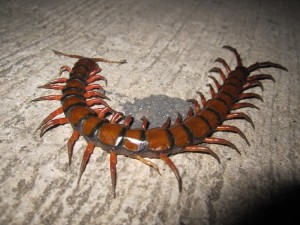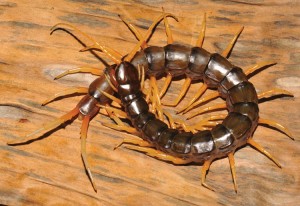Monster Monday: Giant Centipede
Monday, December 26th, 2016December 26, 2016
Some people are brave enough not to scream when they find a creepy, finger-sized house centipede in their home. However, the sight of a forearm-sized Amazonian giant centipede skittering along the wall would cause nearly anyone to shriek and run away. Growing to about 1 foot (30 centimeters) long, the Amazonian giant centipede is the largest living centipede on Earth. Its segmented body is coppery red to dark maroon in color, and its 42 to 46 legs are red or yellow. It lives in the Amazon rain forest and other tropical forests of South America. Like other centipedes, its body does not retain water very well, so it prefers to spend time in humid, moist places, such as leaf litter, rotten logs, and damp caves.

Amazonian giant centipede (Scolopendra gigantea). Credit: Katka Nemčoková (licensed under CC BY-SA 3.0)
Most centipedes feed on insects and spiders, but the Amazonian giant centipede is so large that it also eats such vertebrates (animals with backbones) as lizards, snakes, mice, birds, and frogs. The massive centipede uses its front legs as sharp claws to catch prey. Once an animal is caught, the centipede delivers a terrible bite with its mandibles (jaw structures) and injects a dose of powerful venom that paralyzes its victim, allowing the creepy hunter to enjoy a fresh meal. The Amazonian giant centipede is even known to hunt bats in their roosting caves. With its back legs anchored onto the cave ceiling, the centipede dangles itself upside-down and waits in the darkness to catch a bat in mid-flight.
For people, a bite from an Amazonian giant centipede is extremely painful and can cause swelling, fever, weakness, and vomiting. Luckily, humans are too big for even the biggest centipedes to eat, so Amazonian giant centipedes do not attack humans unless threatened. In fact, many farmers and gardeners in tropical South America are happy to have these many-legged monsters around, because they help to keep pest populations under control.



